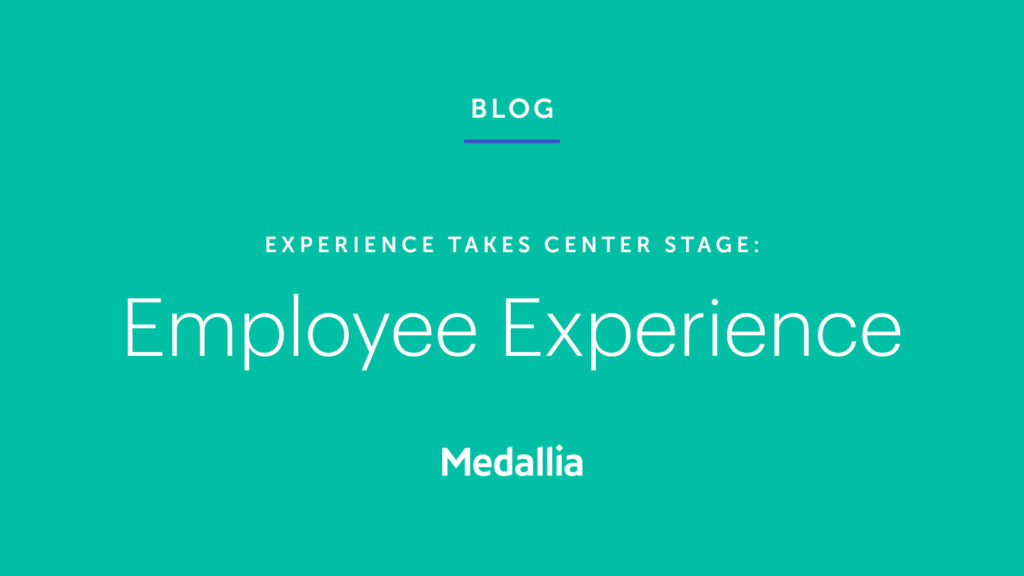Top 5 Takeaways About Employee Experience from Medallia’s Experience 21
June 8, 2021
Employee Experience
Of all the employee experience lessons shared at Experience 21, here are the most crucial takeaways to shape how your organization activates the power of your most valuable asset, your people.
Employee experience as we know it is on the cusp of great change.
With more than one in four employees planning to switch employers in 2021, about 25% cite the need for greater support for their well-being and a desire for more meaningful work as their key motivators for wanting to leave.
That’s why understanding every stage of the employee journey, from recruiting and IT to training and development, must be the new standard. Otherwise, companies risk losing their best people to organizations that are getting things right.
As Medallia’s CEO Leslie Stretch said in his keynote presentation at the start of Experience 21, “At this very moment we are in the midst of a talent revolution that too many companies are still denying exists.”
“Those who are not actively redesigning experiences for a distributed employee workforce, hoping that all this is all just ‘temporary,’ will lose the war for talent,” he added.

At the same time, there are pioneering leaders guiding the way toward being more responsive to employees’ real-time needs, toward creating a culture of empowerment, connectedness, and well-being.
Medallia Experience 21 brought together some of these most innovative and influential voices, leaders who are transforming customer and employee experience as we know it at organizations like State Farm®, Vanguard, the City of San Diego, Birchbox, and more.
Of all the employee experience lessons shared, here are the most crucial takeaways that will shape the way your organization listens to, cares for, engages with, and activates the power of your most valuable asset, your people.
Takeaway #1: Employee experience = customer experience
This was a theme common to countless Experience 21 presentations. In her product keynote, Sarika Khanna, EVP and Chief Product Officer at Medallia, shared this finding: Brands that lead in customer experience — and also the market — have 1.5 times more engaged employees than with the ones with less satisfactory customer experiences. That’s why, as she said in her presentation, “Your employees must be a priority for all stakeholders within the company. That includes not just HR leaders, but also IT and business leaders across the organization.”
That’s a call to action that many in the field are taking head on.
State Farm‘s team is working to go beyond the customer journey and understand the experiences that agents and their employees have and how that affects the customer experience.
E-commerce brands Birchbox, Brooklinen, and Proper Cloth are redefining the customer service agent experience — by prioritizing quality interactions over quantity, celebrating and rewarding agent wins, and taking the time to provide in-the-moment coaching — and revolutionizing the digital customer experience in the process.
At Vanguard, which serves 30 million clients and has 17,000 “crew” members (employees), the company has adopted a new objective: to treat its crew like clients.
“As we started to think about our crew as clients, there was this immediate connection,” said Matt Ohlinger, Head of User Experience, Human Resources at Vanguard. “We know how to serve clients, so why don’t we take those same principles and focus them internally?”
It’s that thinking that inspired the company to launch an employee experience program across the organization’s core people journeys. Implemented in the second half of 2020 with inputs from Vanguard’s HR portal, Salesforce, Workday, and Adobe tools as well as ad-hoc surveys, real-time data and analytics, and closed-loop feedback, the company has seen impressive growth across several key HR metrics.
Both Vanguard and the City of San Diego plan to take things a step further and connect and quantify the effect their employee experience initiatives have on customer experience scores.
Takeaway #2: Employees are struggling like never before, and what organizations are doing isn’t enough
Without a doubt, people are struggling in ways we haven’t seen before, and this carries over to the workplace. Employees and customers feel burnt out, overwhelmed, and more anxious than ever. With these dynamics influencing employee well-being and how employees engage with their customers, the role organizations play in supporting social, emotional, and mental well-being must adapt.
Dan Foy, Associate Principal at Gallup, shared the latest data on employee well-being: Today only 12% of employees strongly agree that they have a better well-being because of their company, and a majority of workers see their work as having direct and negative consequences for their well-being.
“What organizations are doing today isn’t working,” Foy explained. The programs and initiatives companies offer are not “aligned with what employees need.”
Meeting employees’ mental health needs is something leaders need to see as part of their job, he added, sharing four steps companies can take to truly make a difference:
- Make an organizational commitment to a culture of thriving employees, with the directive coming from the top.
- Recognize that well-being is more than physical well-being and wellness. The initiatives your company introduces need to be holistic.
- Equip managers with resources to help their teams, because for many, the employee experience comes down to their interactions with their managers.
- Measure the effectiveness of your employee mental health and wellness programs. Introducing new initiatives is not enough. You need to understand whether your efforts are truly meeting the needs of your employees.
Takeaway #3: How teams collaborate and communicate directly affects organization effectiveness
From watercooler talk to Slack conversations, informal interactions aren’t just spaces for chit chat — they’re spaces for sharing information and forging relationships.
Ben Waber, PhD, President and Co-Founder of Humanyze, conducted research that found the degree of collaboration across departments can impact business outcomes, customer experience, and revenue growth. He calls the connections employees have with other teams within the organization “networks.” His research found that the right types of cohesive networks can lead to creative new ideas.
Increasingly, companies have a lot of data about how employees are interacting across chats, emails, meetings, and collaborative tools. Conducting a network analysis to understand these macro patterns of engagement and productivity can be used to shed light on organizational silos, communication gaps, how quickly new employees become integrated into companies, which teams are at risk for productivity loss, and which collaborative activities and behaviors are having a desired impact.
Not only that, analyzing networks can help companies understand how internal employee interactions influence customer experience. Also, the analysis can provide insights as to how organizations can ensure the right connections get made between teams to lead to the best customer experience outcomes.
An example Waber shared may come as no surprise. For a technical company selling technical products, the greatest prediction of sales performance — more than any other factor, such as working longer hours — was the amount of time the sales team interacted with the engineering team.
Network data can be used to drive workplace decisions, as organizational changes are rolled out, as companies adopt agile transformations, and now as leaders debate what the return to work should look like: fully remote, fully in person, or a hybrid.
Takeaway #4: If you want to improve employee experience, you need timely data
That’s what two large organizations, Northwestern Medicine and the City of San Diego, revealed in their Experience 21 presentations.
Up until recently, Northwestern Medicine relied on an annual employee satisfaction survey to gain insights about the employee experience — a process that involved waiting several weeks to a couple of months for the results. Since teaming up with Medallia, the organization has shifted to offering shorter, more frequent surveys, based on the success of piloting a similar initiative with the company’s customer experience surveys.
There was an “aha” moment, Stratis Bahaveolos, VP of Engagement at Northwestern Medicine, explained. Leaders realized they could see the opportunity to make quick changes — find the so-called “pebble in the shoe,” he said — and have quick wins, solving the known problem of traditional engagement surveys that can lead to disengagement if action isn’t taken fast enough.
Similarly, the City of San Diego with a workforce of 11,000 employees, has shifted from measuring satisfaction every two years to quarterly surveys. Right away, access to more timely insights has helped the company see an opportunity for improvement. With employees asking for more training and learning opportunities, they are rolling out a LinkedIn Learning platform and plan to measure how this new offering impacts their scores.
Takeaway #5: Employee signals are everywhere
Ian Cook, VP of People Analytics at Visier, a data technology company that helps clients like Uber and Unilever understand their teams and make sure they’re taking care of their people, sees the connection between employee experience and customer experience as a three-legged stool. In his Experience 21 talk, he shared that employee experience and customer experience make up two of the three legs, with key events in the employee experience making up the third leg. He revealed some of the most important “events” or signals that employers should pay attention to, including:
- Manager change/instability: Plugging in new managers can be disruptive, and having to adapt to new relationships and working styles can be challenging for the employee
- Delays in events: While keeping track of promotions and role changes is important, another area to keep an eye on is those who may have been passed over for a promotion, particularly if peers have had a chance for growth
- Autonomy: One of Visier’s insurance clients saw customer experience improve when employees felt they had more autonomy
- Employing too few people: Another Visier client within the healthcare industry kept headcount low to save on resources, but found that they were instead incurring costs in the form of absenteeism and overtime and that hiring more people had a better impact on employee experience and the overall patient experience
- Scheduling data from the employee point of view: Schedules alone may reveal whether there is enough coverage, but it won’t tell leaders how employees feel about how much control they have over their working hours, something that can impact both employee and customer experiences.
Learn more by watching these can’t-miss employee experience sessions from Experience 21
- The Powerful Connection between Client Experience and Employee Experience (Vanguard)
- Using a Modern Approach to Employee Experience to Enable Digital Innovation and Agility (Northwestern Medicine)
- Proving the Formula: f(Best of CX)=Best EX (City of San Diego)
- The Impacts of Informal Collaboration on Business Outcomes (Humanyze)
- Brainshare-The Impact of Well-being and Mental Health on Employee and Customer Experiences (Gallup, Capital One)
- Medallia Talks – Visier (Visier)






